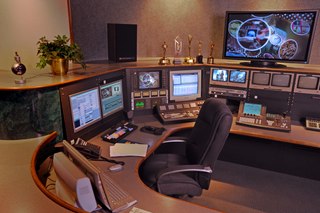
THX 1138 is a 1971 American social science fiction film directed by George Lucas in his feature film directorial debut. It is set in a dystopian future in which the populace is controlled through android police and mandatory use of drugs that suppress emotions. Produced by Francis Ford Coppola and written by Lucas and Walter Murch, it stars Robert Duvall and Donald Pleasence.

Video editing software, or a video editor is software used performing the post-production video editing of digital video sequences on a non-linear editing system (NLE). It has replaced traditional flatbed celluloid film editing tools and analog video tape-to-tape online editing machines.

Non-linear editing is a form of offline editing for audio, video, and image editing. In offline editing, the original content is not modified in the course of editing. In non-linear editing, edits are specified and modified by specialized software. A pointer-based playlist, effectively an edit decision list (EDL), for video and audio, or a directed acyclic graph for still images, is used to keep track of edits. Each time the edited audio, video, or image is rendered, played back, or accessed, it is reconstructed from the original source and the specified editing steps. Although this process is more computationally intensive than directly modifying the original content, changing the edits themselves can be almost instantaneous, and it prevents further generation loss as the audio, video, or image is edited.

A droid is a fictional robot possessing some degree of artificial intelligence in the Star Wars science-fiction franchise. The term is a clipped form of "android", a word originally reserved for robots designed to look and act like a human. The word "android" itself stems from the ancient Greek word "androīdēs", meaning "manlike".

THX Ltd. is an American company founded in 1983 by George Lucas and headquartered in San Francisco, California. It develops the "THX" high fidelity audio/visual reproduction standards for movie theaters, screening rooms, home theaters, computer speakers, gaming consoles, car audio systems, and video games. THX Ltd. is a subsidiary of Razer Inc.
Avid Technology is an American technology and multimedia company based in Burlington, Massachusetts, and founded in August 1987 by Bill Warner. It specialises in audio and video; specifically, digital non-linear editing (NLE) systems, video editing software, audio editing software, music notation software, management and distribution services.

Video editing is the manipulation and arrangement of video shots. Video editing is used to structure and present all video information, including films and television shows, video advertisements and video essays. Video editing has been dramatically democratized in recent years by editing software available for personal computers. Editing video can be difficult and tedious, so several technologies have been produced to aid people in this task. Pen based video editing software was developed in order to give people a more intuitive and fast way to edit video.
A hard disk recorder (HDR) is a system that uses a high-capacity hard disk to record digital audio or digital video. Hard disk recording systems represent an alternative to reel-to-reel audio tape recording and video tape recorders, and provide non-linear editing capabilities unavailable using tape recorders. Audio HDR systems, which can be standalone or computer-based, are typically combined with provisions for digital mixing and processing of the audio signal to produce a digital audio workstation (DAW).

The LaserDisc (LD) is a home video format and the first commercial optical disc storage medium, initially licensed, sold and marketed as MCA DiscoVision in the United States in 1978. Its diameter typically spans 30 cm (12 in). Unlike most optical disc standards, LaserDisc is not fully digital and instead requires the use of analog video signals.

Final Cut Pro is a series of non-linear video editing software programs first developed by Macromedia Inc. and later Apple Inc. The most recent version, Final Cut Pro 10.6.3, runs on Mac computers powered by macOS Big Sur 11.5.1 or later. The software allows users to log and transfer video onto a hard drive, where it can be edited, processed, and output to a wide variety of formats. The fully rewritten Final Cut Pro X was introduced by Apple in 2011, with the last version of the legacy Final Cut Pro being version 7.0.3.

Walter Scott Murch is an American film editor, director, writer and sound designer. With a career stretching back to 1969, including work on THX 1138, Apocalypse Now, The Godfather I, II, and III, American Graffiti, The Conversation, and The English Patient, with three Academy Award wins, he has been referred to by Roger Ebert as "the most respected film editor and sound designer in the modern cinema".

Analog Devices, Inc. (ADI), also known simply as Analog, is an American multinational semiconductor company specializing in data conversion, signal processing and power management technology, headquartered in Wilmington, Massachusetts.
Quantel was a company based in the United Kingdom and founded in 1973 that designed and manufactured digital production equipment for the broadcast television, video production and motion picture industries. They were headquartered in Newbury, Berkshire.

Avid Media Composer is a film and video editing software application or non-linear editing system (NLE) developed by Avid Technology. Initially released in 1989 on Macintosh II as an offline editing system, the application has since evolved to allow for both offline and online editing, including uncompressed standard definition (SD), high definition (HD), 2K and 4K editing and finishing. Since the 1990s, Media Composer has been the dominant non-linear editing system in the film and television industry, first on Macintosh and later on Windows. Avid NewsCutter, aimed at newsrooms, Avid Symphony, aimed at finishing, were all Avid products that were derived from Media Composer and share similar interfacing, as were Avid Xpress Pro and its predecessor Avid Xpress DV, which were aimed at the lower end of the market.
Sonic Studio is an American company manufacturing digital audio production tools for engineering professionals. The company was created when Sonic Solutions divested itself of its audio product lines in order to concentrate on DVD and multimedia–oriented products.
The Audio Signal Processor or ASP is a large-scale digital signal processor developed by James A. Moorer at Lucasfilm's The Droid Works. He programmed a number of Digital signal processing algorithms that were used in major motion picture features. Sounds processed by the ASP were used in the THX logo's Deep Note, Return of the Jedi, Indiana Jones and the Temple of Doom, and others.
The SoundDroid is an early digital audio workstation designed by a team of engineers led by James A. Moorer at Lucasfilm between 1980 and 1987. It was a hard-disk–based, nonlinear audio editor developed on the Audio Signal Processor (ASP), a large-scale digital signal processor for real-time, multichannel equalization and audio mixing.
James Anderson Moorer is a digital audio and computer music engineer, responsible for over 40 technical publications and four patents.










